PREVIOUS EDITIONS
pEER-REVIEWED PUBLICATIONS fROM COLLABORATIONS BORN AT COMPLEXITY72H
Beatriz Arregui-Garcia, Claudio Ascione, Arianna Pera, Boxuan Wang, Davide Stocco, Colin J. Carlson, Shweta Bansal, Eugenio Valdano, Giulia Pullano
Disruption of outdoor activities caused by wildfire smoke shapes circulation of respiratory pathogens
PLOS Climate (2025)
Kishor Acharya, Javier Aguilar, Lorenzo Dall’Amico, Kyriacos Nicolaou, Sandro Meloni and Enrico Ser-Giacomi
Comparing temporal and aggregated network descriptions of fluid transport in the Mediterranean Sea
Physical Review E (2025)
Anees Baqir, Yijing Chen, Fernando Diaz-Diaz, Sercan Kiyak, Thomas Louf, Virginia Morini, Valentina Pansanella, Maddalena Torricelli and Alessandro Galeazzi
Unveiling the Drivers of Active Participation in Social Media Discourse
Scientific Reports (2025)
Filippo Zimmaro, Manuel Miranda, José María Ramos Fernández, Jesús A. Moreno López, Max Reddel, Valeria Widler, Alberto Antonioni and The Anh Han
Emergence of cooperation in the one-shot Prisoner’s dilemma through Discriminatory and Samaritan AIs
Journal of Royal Society Interface (2024)
Alexandre Bovet, Carlo Campajola, Francesco Mottes, Valerio Restocchi, Nicolò Vallarano, Tiziano Squartini and Claudio J. Tessone
The Evolving Liaisons between the Transaction Networks of Bitcoin and Its Price Dynamics
JPS Conference Proceedings (2023)
Benjamin Steinegger, Iacopo Iacopini, Andreia Sofia Teixeira, Alberto Bracci, Pau Casanova-Ferrer, Alberto Antonioni and Eugenio Valdano
Non-selective distribution of infectious disease prevention may outperform risk-based targeting
Nature Communications (2022)
MADRID 2024
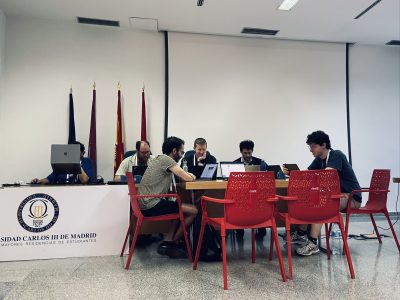





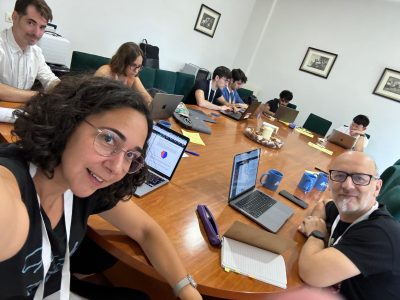
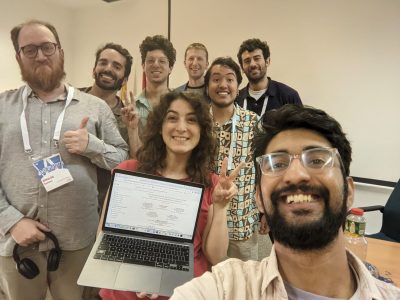
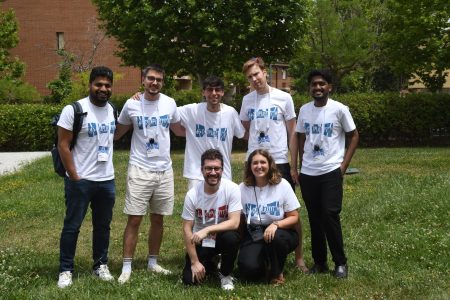
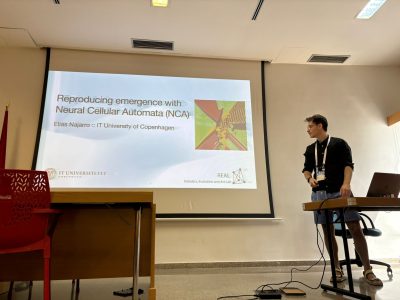
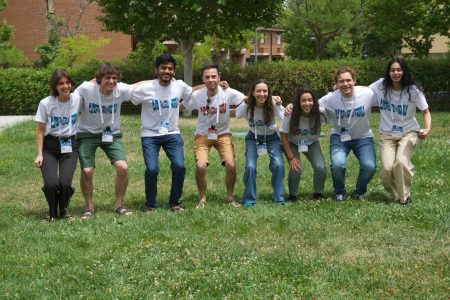




72H PREPRINTS
Sampled Datasets Risk Substantial Bias in the Identification of Political Polarization on Social Media
arXiv
(Di Bona, Fraxanet, Komander, Lo Sasso, Morini, Vendeville, Falkenberg, Galeazzi)
Enhancing stop location detection for incomplete urban mobility datasets
arXiv
(Bertè, Ibrahimli, Koopmans, Valgañón, Zomer, Colombi)
A 72h exploration of the co-evolution of food insecurity and international migration
arXiv
(Cassels, Constantini, Ashery, Gadge, Pires, Sánchez-Cortés, Santoro, Omodei)
Exploring the interplay of individual traits and interaction dynamics in preschool social networks
arXiv
(Akçakır, Azaiez, Ceria, Eminente, Ferranti, Gandhi, Raj, Iacopini)
Disentangling individual-level from location-based income uncovers socioeconomic preferential mobility and impacts segregation estimates
arXiv
(Duran-Sala, Balachandran, Morandini, Naushirvanov, Prabhakaran, Renninger, Mazzoli)
Modeling the impacts of COVID-19 mobility disruptions
on Respiratory Syncytial Virus (RSV) transmission in
Seattle, Washington
arXiv
(Duddu, Elgamal, Camacho-Mateu, Holubowska, Rella, Bents, Viboud, Hansen, Pullano, Perofsky)
Assessing metro networks efficiencyusing max-plus algebra
arXiv
(Aboumad, Blibeche, Hari, Liu, Neven, Parameswaran, Patel)
Computational approaches to understanding oxygen diffusion in cancer growth dynamics
arXiv
(Briñas, Capelli, Lambresa, Lee, Najarro, Roy, Galeano, Guerrero)
LECTURES & TUTORIALS
Daniela Paolotti
M. Ángeles Serrano
Ricard Solé
Fundamental constraints to the logic of living systems
(Tutorial: Firas Blibeche)
Detecting and Visualizing Synchronisation in Complex Bipartite Data
(Tutorial: Andrea Lo Sasso)
Machine learning with unbalance datasets
(Tutorial: Elias Najarro)
Reproducing emergent phenomena with Neural Cellular Automata
(Tutorial: Gülşah Akçakır)
Introduction to Agent-based Modeling with NetLogo
(Tutorial: Islam Elgamal)
Network Visualization and Analysis of the Public Transportation Network of Munich
TUTORS & LECTURERS
DANIELA PAOLOTTI (lecturer):
Daniela got her PhD in Physics from the University of Camerino, Italy in 2005. She is Research Leader in the Computational Epidemiology and Public Health group at ISI Foundation in Turin. Before joining ISI in 2008, she was a researcher in the Bioinformatics group at the Novartis Vaccine Research Center in Siena. Her main interest is in digital and computational epidemiology. At ISI she coordinates the Europe-wide network of platforms for Web-based surveillance of influenza called Influenzanet.
M. ÁNGELES SERRANO (lecturer): M. Ángeles is an ICREA Research Professor at the Dept. of Condensed Matter Physics of the University of Barcelona (UB). She holds a Ph.D. in theoretical physics from UB and a master in mathematics for finance from the Centre de Recerca Matemàtica CRM. After four years as IT consultant and mutual fund manager, she returned to academia in 2004 to work in complexity science within the franework of network science. She conducted postdoctoral research at Indiana University (USA), the EPFL (Switzerland), and IFISC Institute (Spain). She came back to Barcelona in 2009, when she was awarded a Ramón y Cajal Fellowship at UB. M. Ángeles obtained the Outstanding Referee Award of the American Physical Society and belongs to the Editorial Board of the APS journal Physical Review Research. She is a founding member of Complexitat, the Catalan network for the study of complex systems, and a promoter member of UBICS, the UB Institute of Complex Systems.
RICARD SOLE (lecturer): Ricard is an ICREA research professor (the Catalan Institute for research and Advanced Studies) currently working at the Universitat Pompeu Fabra, where he is the head of the Complex Systems Lab located at the PRBB. He teaches undergraduate courses on Biomathematics, Biological Design and Complex Diseases. He completed degrees in both Physics and Biology at the University of Barcelona and received his PhD in Physics at the Polytechnic University of Catalonia. He is also External Professor of the Santa Fe Institute (New Mexico, USA), Fellow of the European centre for Living Technology (Venice, Italy), external faculty at the Center for Evolution and Cancer at UCSF and at the Vienna’s Complex Systems Hub . He is also member of the editorial board of Biology Direct and PLoS ONE. He has received a European Research Council Advanced Grant (ERC 2012) and support from the Fundación Botin. He has also been science advisor of the CCCB exhibit +HUMANS (on the future of our species) and organiser of the Xmas Lectures (Ciencia al Nadal) in Barcelona, also held at the CCCB.
JACOPO FREGONI (guest lecturer): Jacopo is Associate Editor at the Communications Physics —a journal of the Nature Portfolio journal— since 2023.
He obtained his PhD in Physics and Nanosciences from the University of Modena and Reggio Emilia in 2020, investigating via quantum methods the dynamics of molecules in nanocavities. The main work produced during his PhD was awarded with two prizes by the Italian Chemical Society as young chemist best scientific work of 2020. He then conducted post-doctoral research at the Universidad Autónoma de Madrid, where he expanded his theoretical research interests to the modelling of the interaction between complex electromagnetic environments and material structures, and the phenomenology emerging from it. At Communications Physics, Jacopo handles optics and photonics, atomic and molecular physics, and part of the network science submissions.
ALESSANDRO GALEAZZI – MAX FALKENBERG (tutors): University of Padova, Padova, Italy and University of London, London, United Kingdom
AMANDA PERFORSKY (tutor): University of Washington, Washington, USA
DAVIDE COLOMBI (tutor): Cuebiq, Milan, Italy
EBRAHIM PATEL (tutor): Georgetown University of Greenwich, London, United Kingdom
ELISA OMODEI (tutor): Central European University, Vienna, Austria
IACOPO IACOPINI (tutor): Northeastern University, London, United Kingdom
MATTIA MAZZOLI (tutor): ISI Foundation, Turin, Italy
PILAR GUERRERO and JAVIER GALEANO (tutors):GISC, Universidad Carlos III de Madrid, Madrid, Spain
ORGANIZERS & SUPPORTERS
ALBERTO ANTONIONI
MIGUEL A. GONZÁLEZ CASADO
GIULIA PULLANO
EUGENIO VALDANO





PALMA DE MALLORCA 2023
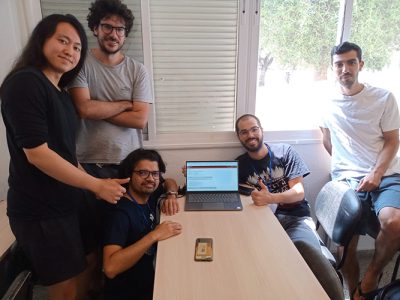



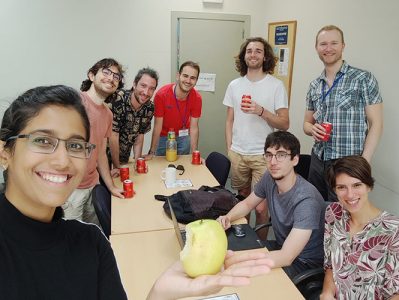


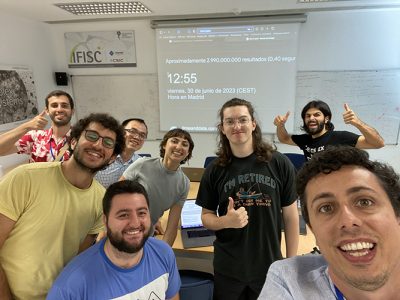

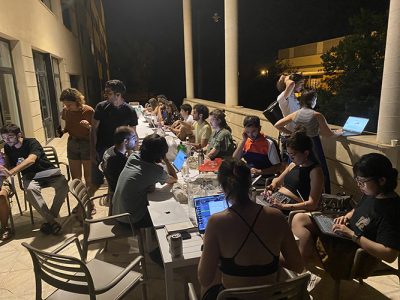
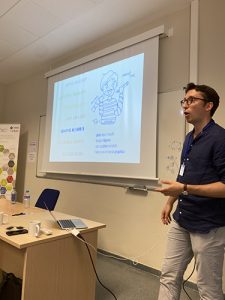


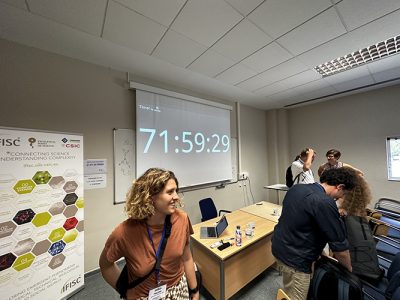
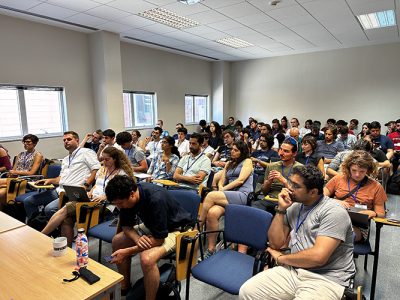
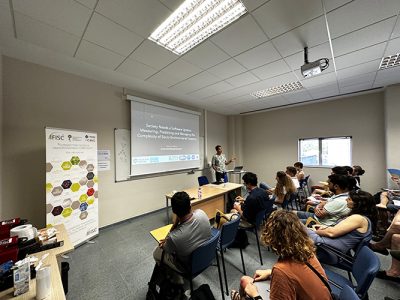
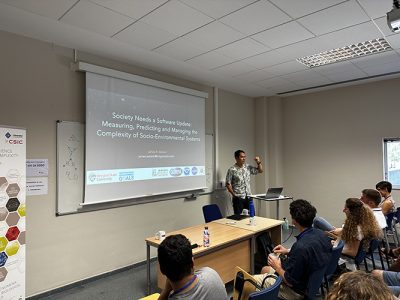
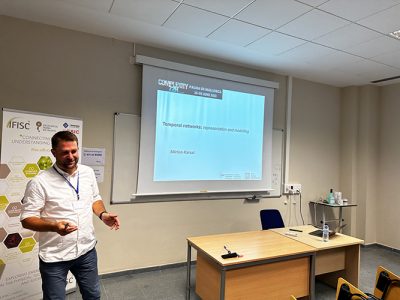
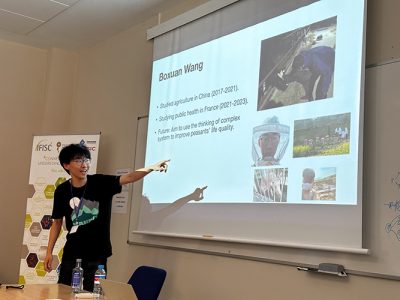
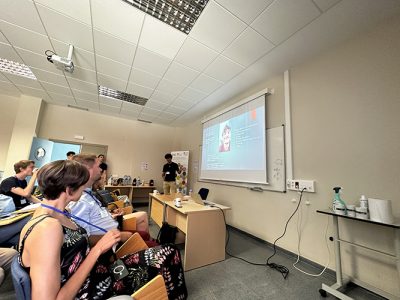

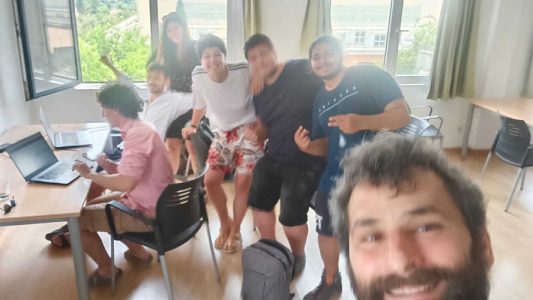
72H PREPRINTS
Ethics in rotten apples: A network epidemiology approach for active cyber defense
arXiv
(Bonacina, Echegoyen, Escribano, Krellner, Nerini, Shanaz, Teixeira, Aleta)
Spaces of innovation and venture formation: the case of biotech in the United Kingdom
arXiv
(Marzolla, Nowak, Sahasrabuddhe, Singh, Straccamore, Zhivkoplias, Arcaute)
Unraveling higher-order dynamics in collaboration networks
arXiv
(Abella, Birello, Di Gaetano, Ghivarello, Sabhahit, Sirocchi, Fernandez-Gracia)
Beyond Active Engagement: The Significance of Lurkers in a Polarized Twitter Debate
arXiv
(Baqir, Chen, Diaz-Diaz, Kyak, Louf, Morini, Pansanella, Torricelli, Galeazzi)
Discriminatory or Samaritan — which AI is needed for humanity? An Evolutionary Game Theory Analysis of Hybrid Human-AI populations
arXiv
(Booker, Miranda, Moreno Lopez, Ramos Fernandez, Reddel, Widler, Zimmaro, Antonioni, Anh Han)
Disruption of outdoor activities caused by wildfire smoke shapes circulation of respiratory pathogens
arXiv
(Arregui Garcia, Ascione, Pera, Stocco, Wang, Valdano, Pullano)
Temporal network-based analysis of fluid flow with applications to marine ecology
arXiv
(Acharya, Aguilar, Dall’Amico, Nicolaou, Tong, Ser-Giacomi)
LECTURES & TUTORIALS
Marton Karsai
Temporal networks: representation and modeling
Jesús Gómez-Gardeñes
James Watson
Society needs a software update: Measuring, predicting and managing the complexity of socio-environmental systems
(Tutorial: Fernando Diaz-Diaz)
Structure and dynamics of signed networks
(Tutorial: Manuel Miranda)
Introduction to Otree and graph representation using Cytoscape
(Tutorial: Max Reddel)
Decision-Making under Deep Uncertainty: Steering Through the Complex Storm
(Tutorial: Rasha Shanaz)
Build your own reservoir computer from scratch with ReservoirPy
TUTORS & LECTURERS
MÁRTON KARSAI (lecturer): Márton Karsai is an Associate Professor at the Department of Network and Data Science at the Central European University in Vienna and a researcher at the Rényi Institute of Mathematics in Budapest. He is a network scientist with research interest in human dynamics, computational social science, and data science, especially focusing on heterogeneous temporal dynamics, spatial and temporal networks, socioeconomic systems and social contagion phenomena. He is an expert in analysing large human behavioural datasets and in developing data-driven models of social phenomena.
JESÚS GÓMEZ-GARDEÑES (lecturer): Jesús is an Associate Professor (Profesor Titular) in the Department of Condensed Matter Physics of the University of Zaragoza (Spain). He leads the Group of Theoretical & Applied Modeling (GOTHAM lab) at the Institute of Biocomputation and Physics of Complex Systems (BIFI).
JAMES WATSON (lecturer): James Watson is an Associate Professor in the College of Earth, Ocean and Atmospheric Sciences at Oregon State University. He and his lab develop mathematical theory and computational methods for application in the domains of ecology, geography, oceanography and sustainability science. He takes inspiration from complex adaptive systems more generally, and in addition to his work on socio-environmental systems he conducts research into financial markets, resource economics and sports data analytics. He is interested in learning from all complex systems to help improve our ability to live sustainably. Previously, he received his PhD in Marine Science from the University of California Santa Barbara, and spent time as a post-doctoral researcher at Princeton University and as a research scientist at the Stockholm Resilience Centre. Hen was the recipient of a DARPA Young Faculty Award and the Oceanography Society’s Early Career Award for his interdisciplinary work.
ALBERTO ALETA (tutor): University of Zaragoza, Zaragoza, Spain.
ELSA ARCAUTE (tutor): UCL, London, UK
JUAN FERNANDEZ-GARCIA (tutor): IFISC, Palma de Mallorca, Spain
ALESSANDRO GALEAZZI (tutor): Ca’ Foscari University of Venice, Venice, Italy
THE ANH HAN (tutor): University, Middlesbrough, England, UK
GIULIA PULLANO (tutor): Georgetown University, Washington, DC, USA
ENRICO SER-GIACOMI (tutor): IFISC, Palma de Mallorca, Spain
ORGANIZERS & SUPPORTERS
ALBERTO ANTONIONI
SOFIA TEXEIRA
MADDALENA TORRICELLI
EUGENIO VALDANO
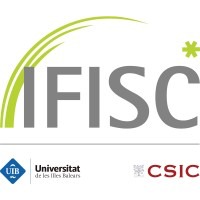


ROME 2020
COMPLEXITY 72H
Due to the pandemic, the Complexity72h 2020 edition has been cancelled.
LECTURES & TUTORIALS
Due to the pandemic, the Complexity72h 2020 edition has been cancelled.
ORGANIZERS & SUPPORTERS
ALBERTO ANTONIONI
SOFIA TEIXEIRA
EUGENIO VALDANO
MATEUSZ WILINSKI
TUTORS & LECTURERS
ELSA ARCAUTE: Elsa is a physicist with a masters in Mathematics and a PhD in Theoretical Physics from the University of Cambridge, UK. She is an Associate Professor in Spatial Modelling and Complexity at the Centre for Advanced Spatial Analysis (CASA), and Co-Investigator of an EPSRC grant on Digital Economies, and a MacArthur funded research project on Smart Cities. website
ALAIN BARRAT: Alain obtained his PhD in theoretical physics at the university of Paris VI. He is currently CNRS senior researcher at the Centre de Physique Théorique in Marseille, of which he is also deputy director. He is also Specially Appointed Professor at Tokyo Institute of Technology (Japan), vice-president of the Complex Systems Society, and board member of the NetSci Society. His research focuses on complex networks and temporal networks, with many interdisciplinary connections. website
ANA BENTO: Ana is an Assistant Professor at Indiana University in Epidemiology & Biostatistics, School of Public Health & the EEB department. She is an eco-epidemiologist with a focus on ecology and evolution of infectious diseases. She earned her Ph.D. in Ecology & Evolution at Silwood Park, Imperial College London. Her research seeks to understand the dynamics of biological populations and epidemics, focusing on how to bring experimental and observational data together with mathematical theory. website
ELISA OMODEI: Elisa holds a PhD in Applied Mathematics for the Social Sciences from the École Normale Supérieure of Paris. She currently works in the Research, Assessment and Monitoring division of the UN World Food Programme. She also serves as Vice-President Secretary of the Complex System Society. Her research focuses on complex networks and data science for development and humanitarian response. website
LETO PEEL: Leto has over 10 years of experience in theoretical and applied machine learning research in both academia and industry. His current research interest is in developing statistical methods for analysing complex networks. He has worked on many interdisciplinary research projects, collaborating with experts from a diverse variety of domains. His industry collaborations have included Airbus, BAE Systems and London MET Police and has collaborated with a variety of academic institutions. website
LIUBOV TUPIKINA: Liubov has been working in mathematics and statistical physics: she is interested in graph theory, random walks, dynamical systems, matrix theory and its applications. She has been working on projects applying stochastic processes and statistical learning to analyze trajectories and time-series data. Currently she is a researcher at Bell labs (Saclay, France) and CRI (Paris, France). Before she has been working at Ecole Polytechnqiue (France), Humboldt University in Marie-Curie project along with Potsdam Climate Institute (Germany), IFISC (Spain). website
LUCCA 2019







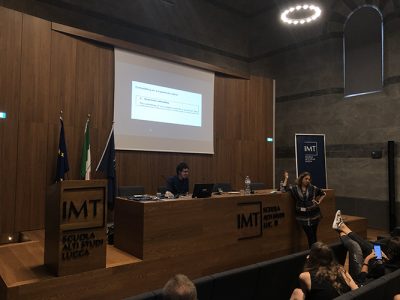

72H PREPRINTS
Community Detection in the Hyperbolic Space
arXiv
(Bruno, Sousa, Gursoy, Serafino, Vianello, Vranić, Boguñá)
Evaluating the impact of PrEP on HIV and gonorrhea on a networked population of female sex workers
arXiv
(Bernini, Blouzard, Bracci, Casanova, lacopini, Steinegger, Teixeira, Antonioni, Valdano)
Inside the Echo Chamber: Disentangling network dynamics from polarization
arXiv
(Balsamo, Gelardi, Han, Rama, Samantray, Zucca, Starnini)
Maximum entropy approaches for the study of triadic motifs in the Mergers & Acquisitions network
arXiv
(Adam, Garlaschi, Lin, Piaggesi, Barigozzi, Gabrielli, Mastrandrea)
Shall we turn off the media? Global information can destroy local cooperation in the one-dimensional ring
arXiv
(Aydin, Biondo, Gupta, Ivaldi, Lipari, Lozano, Parino, Bilancini, Boncinelli, Capraro)
Simplex2Vec embeddings for community detection in simplicial complexes
arXiv
(Billings, Hu, Lerda, Medvedev, Mottes, Onicas, Santoro, Petri)
LECTURES & TUTORIALS
Susanna Manrubia
Viral war games: When evolution defeats imagination
Viruses count amongst the most amazing organisms on Earth regarding their evolutionary and adaptive abilities. They resort to several different forms of coding information in their genomes; together with an array of different mutational mechanisms, they have succeeded in infecting all cellular organisms and in escaping any antiviral strategy (natural or artificial). We will present two examples of viral adaptive strategies that can be formally addressed: the complex population response to combinations of antiviral drugs and the advantages of viruses with multipartite genomes. Finally, we will briefly discuss the origin of viruses and the role they may have played in the evolution of life.
Fabrizio Lillo
Dynamical models of temporal networks
Many complex systems can be described as temporal networks, i.e. networks where links appear and disappear with time. Given the high dimensionality of the problem, suitable models are needed, especially if one is interested in parameter or hidden variable estimation, link forecasting, and analytical modelling the propagation of a signal on the network. In this lecture I will present some recent advancement in the field, introducing stationary and non-stationary models with application to financial and social temporal networks.
Marián Boguñá
Network geometry. A geometric approach to complex networks
The main hypothesis of the network geometry program states that the architecture of real complex systems has a geometric origin. In a nutshell, the idea is that the elements of a complex system can be characterized by their positions in some underlying metric space so that the observable network topology —abstracting their patterns of interactions— is a reflection of their distances in this space. This simple idea has led to the development of a very general framework able to explain the most ubiquitous topological properties of real complex networks, namely, degree heterogeneity, the small-world property, and high levels of clustering. Network geometry is also able to explain in a very natural way non-trivial properties of real networks, like their self-similarity and community structure, their navigability properties, and is the basis for the definition of a renormalization group in complex networks. The same framework has also been successfully extended to weighted networks and multiplexes. In this lecture, I will review the work done in this field of research during the last ten years and discuss the applications of network geometry to many open problems in network science.
Claudio Tessone
A complex systems approach to cryptocurrencies
Cryptocurrencies are possible because their public ledgers allow the storage of trustworthy information without the pre-requisite of trust between system participants. However, for this property to be preserved, ‘who’ writes these data into the ledger must be acceptable to all. Thus, centralisation of any kind is against the core principle of blockchain-based systems. Cryptocurrencies are the most widely adopted incarnation of blockchains. They are plagued with economic incentives, many of them obvious, some others put inadvertently. In this presentation we will review different links between microscopic agent behaviour and macroscopic emergent properties of cryptocurrencies.
The lecture consists of three parts: Wealth dynamics, financial markets and dark markets. In the first part of the lecture, we will explain the increasing concentration on wealth (and power!) in different cryptocurrencies, and link it to underlying design principles. In the second, we will explain the relationship between endogenous activity in cryptocurrencies and price dynamics with respect to fiat currencies. Finally, the third part will delve into the circulation (and relative size!) of illegal trades in cryptocurrencies.
Multiresolution Filterbanks to Enhance Signal Contrast
(Speaker: Jacob Billings)
The tutorial explores the use of wavelet filters to enhance feature detection among time series. Wavelet filters are especially useful at localizing deviations from ongoing dynamics. The tutorial will demonstrate the use of several wavelet filtration schema–including continuous, discrete, and bi-orthogonal–to enhance data-driven feature detection in time-series.
Unravelling the topological arrangements and selected reaction parameters from global measurements of an extended neural model
(Speaker: Ihusan Adam)
Living brains show immensely complex dynamics that are often modelled by ensembles of simple neuron models connected through a network of intricate structure. The complexity displayed by these systems stem from the topology of the network support. To gain an insight into this problem, we propose and test a procedure that is aimed at reconstructing the a priori unknown architecture of the embedding network. To this end we consider and extended model of Leaky-Integrate and Fire (LIF) neurons with short-term plasticity. The neurons are coupled to directed network and display a level of heterogeneity in the associated current a, which dictates the ring regime in which a neuron is operating in. The aim of the method is to recover the distribution of connectivity k ̃ of the underlying networks as well as the distribution of the assigned a. Our approach to the inverse problem makes use of the celebrated Heterogenous Mean-Field (HMF) approximation to rewrite the dynamics of the system by splitting the types of neurons into classes which re ect the associated a and in-degree k ̃. The HMF reduction scheme allows us to in essence, create a mesh on the space de ned by the variables a and k ̃ in such a way that all possible neurons fall within this space. The two sought distributions of P(a) and P(k ̃) are then the correct solutions that sum the classes of neurons to reproduce the global eld that was obtained by simulating the original model. We have tested this on synthetic data, where the global eld was generated by a random network and a bell-shaped distribution of currents, and here the method captures the two distributions remarkably well and manages to almost exactly reproduce the global field.
The Origins of Social Balance in Signed Networks
(Speaker: Sofia Teixeira Monteiro)
Social media often reveals a complex interplay between positive and negative ties. And real online social networks are proven to show high social balance. Yet, the origin of such complex patterns of interaction remains largely elusive. In this work we study how third parties may sway our perception of others. We build a model of peer-influence relying on the analysis of all triadic relations taking into account the relations with common friends. We show that this simple peer-influence mechanism, based on balance theory of social sciences, is able to promptly increase the social balance of a signed network.
TUTORS & LECTURERS
Marián BOGUÑÁ (lecturer/tutor): Marián Boguñá is an associate professor and Icrea Academia researcher at the Dept of Condensed Matter Physics, University of Barcelona, Spain. Currently, his main research interests focus on Complex Systems and Complex Networks, two exciting and multidisciplinary fields of research that apply Statistical Physics techniques to the understanding of the many networked systems around us. website
Fabrizio LILLO (lecturer): Fabrizio Lillo is full Professor of Mathematical Methods for Economics, Finance, and Actuarial Sciences at the University of Bologna, Italy. website
Susanna MANRUBIA (lecturer): Susanna Manrubia is a research leader at the National Biotechnology Center (CSIC), Madrid, Spain. website
Claudio TESSONE (lecturer/tutor): Claudio J. Tessone is assistant professor at the Dept of Business Administration of the University of Zurich. He applies network analysis to socio-economical systems. website
Ennio BILANCINI (tutor): Ennio Bilancini is a professor of economics at IMT School of Advanced Studies, Lucca. He has conducted research in the areas of cognitive and behavioral economics, economic theory, (evolutionary) game theory, microeconomics, social economics, subjective well-being and welfare. He is currently interested (and prompt to supervise students interested) in the evolution of prosociality, evolutionary selection of game equilibria, measurement of strategic skills, measurement of bounded rationality, dual process interactive decision-making, economics of social status and social norms, social determinants of subjective well-being. website
Valerio CAPRARO (tutor): Valerio is a senior lecturer in economics at Middlesex University of London, UK. He combines math models and behavioral experiments to understand how people solve cooperative tasks, with the goal of helping institutions to create more collaborative societies. website
Andrea GABRIELLI (tutor): Andrea Gabrielli is a permanent researcher at the Institute of Complex Systems (ISC) of the Italian CNR. He works in statistical physics, fractal growth phenomena, percolation, self-organized criticality, application of statistical physics to cosmological and gravitational problems. His main present interest focuses on the applications of complex networks and stochastic processes to economy and brain science. website
Laetitia GAUVIN (tutor): Laetitia Gauvin is a research leader at ISI Foundation, Turin, Italy. website
Giovanni PETRI (tutor): Giovanni Petri is a research leader at ISI Foundation, Turin, Italy. website
Michele STARNINI (tutor): Michele Starnini is a researcher at ISI Foundation, Turin, Italy. website
Eugenio VALDANO (tutor): Eugenio is a postdoc at University of California, Los Angeles, USA. He is a physicist and epidemiologist. He works in infectious disease modeling. His current focus is the HIV epidemic in Sub-Saharan Africa. website
ORGANIZERS & SUPPORTERS
ALBERTO ANTONIONI
ROSSANA MASTRANDREA
TIZIANO SQUARTINI
EUGENIO VALDANO


LUCCA 2018
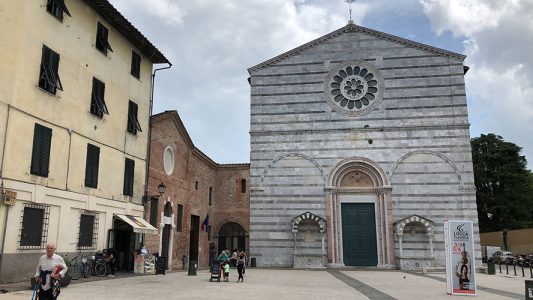

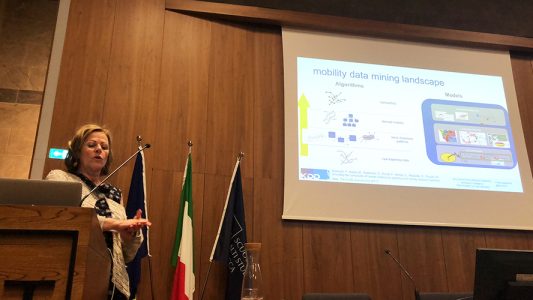
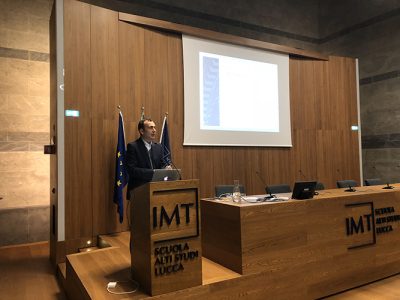
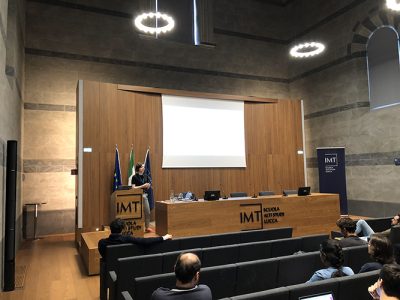
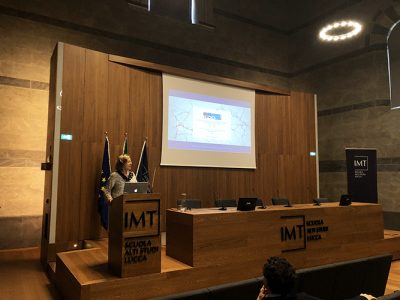
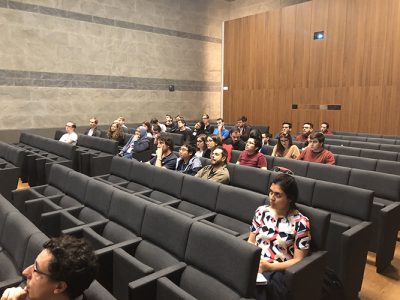




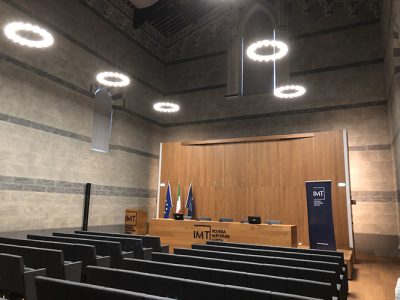


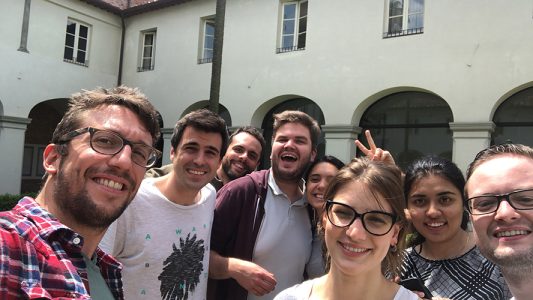
72H PREPRINTS
Altered modularity and disproportional integration in functional networks are markers of abnormal brain organization in schizophrenia
arXiv
(Cinelli, Echegoyen, Oliveira, Orellana, Gili)
Dynamics of new strain emergence on a temporal network
arXiv
(Chakraborty, Hoffmann, Leguia, Nolet, Ortiz, Prunas, Zavojanni, Valdano, Poletto)
Maximum entropy approach to link prediction in bipartite networks
arXiv
(Baltakiene, Baltakys, Cardamone, Parisi, Radicioni, Torricelli, van Lidth de Jeude, Saracco)
Network-based indicators of Bitcoin bubbles
arXiv
(Bovet, Campajola, Lazo, Mottes, Pozzana, Restocchi, Saggese, Vallarano, Squartini, Tessone)
Network sensitivity on systemic risk
arXiv
(Di Gangi, Lo Sardo, Macchiati, Minh, Pinotti, Ramadiah, Wilinski, Cimini)
LECTURES & TUTORIALS
Fosca Giannotti (lecture)
Big Data for understanding human dynamics: the power of networks
Claudio Tessone (lecture)
A complex systems perspective to blockchain-based systems
Chiara Poletto (lecture)
Introduction to network epidemiology
Guido Caldarelli (lecture)
Application of statistical physics to finance
Paolo Barucca (tutorial)
Network models of systemic risk
Marcos Oliveira (tutorial)
Performing embarrassingly parallel data analysis in Python using IPyparallel and Pandas
Ruggiero Lo Sardo (tutorial)
Web visualization of small scale complex networks
Alexandre Bovet (tutorial)
Uncovering memory patterns in temporal networks with higher-order Markov models
Tommaso Radicioni (tutorial)
How to use Gephi? A short introduction to network analysis and visualization
TUTORS & LECTURERS
GUIDO CALDARELLI (lecturer): Guido Caldarelli is full professor of physics at IMT Lucca, and LIMS fellow. He is vice-president of the Complex Systems Society, and in the board of the statistical and nonlinear physics division of the European Physical Society. His research interests involve structure of networks, financial networks, and multiplex networks. website
FOSCA GIANNOTTI (lecturer): Fosca Giannotti is a senior researcher at the Information Science and Technology Institute of the National Research Council at Pisa, Italy, where she leads the Knowledge Discovery and Data Mining Laboratory. Her current research interests include data mining query languages, knowledge discovery support environment, web-mining, spatio-temporal reasoning, spatio-temporal data mining, and privacy preserving data mining. website
CHIARA POLETTO (lecturer): Chiara Poletto is a researcher at INSERM (French National Institute of Health and Medical Research). She studies emerging pathogens and disease ecology. She applies network physics and complex system approaches to reach a theoretical understanding of the interplay between human behaviour and infection propagation, using data-driven computational models. Her goal is to provide a quantitative assessment forecast of the epidemic evolution. website
CLAUDIO J. TESSONE (lecturer): Claudio J. Tessone is assistant professor at the Dept of Business Administration of the University of Zurich. He applies network analysis to socio-economical systems. website
GIULIO CIMINI (tutor): Giulio Cimini is assistant professor in Quantitative Analysis and Modeling of Complex Economical and Financial Systems at IMT Lucca. website
ANGELO FACCHINI (tutor): Angelo Facchini is Assistant Professor at IMT Lucca. His research interests are in the field of nonlinear time series analysis, complex systems and data science with applications to biophysical phenomena, markets, infrastructural water and energy networks, urban sustainability, and megacities. website
TOMMASO GILI (tutor): Tommaso Gili currently works at the NETWORKS Complex Networks Research Unit, IMT School for Advanced Studies Lucca. Tommaso does research in Polymer Chemistry, Physical Chemistry and Biophysics. website
FABIO SARACCO (tutor): Fabio Saracco is assistant professor at IMT Lucca, since October 2015, when he joined the NETWORKS research unit. website
ORGANIZERS & SUPPORTERS
ALBERTO ANTONIONI
TIZIANO SQUARTINI
EUGENIO VALDANO



